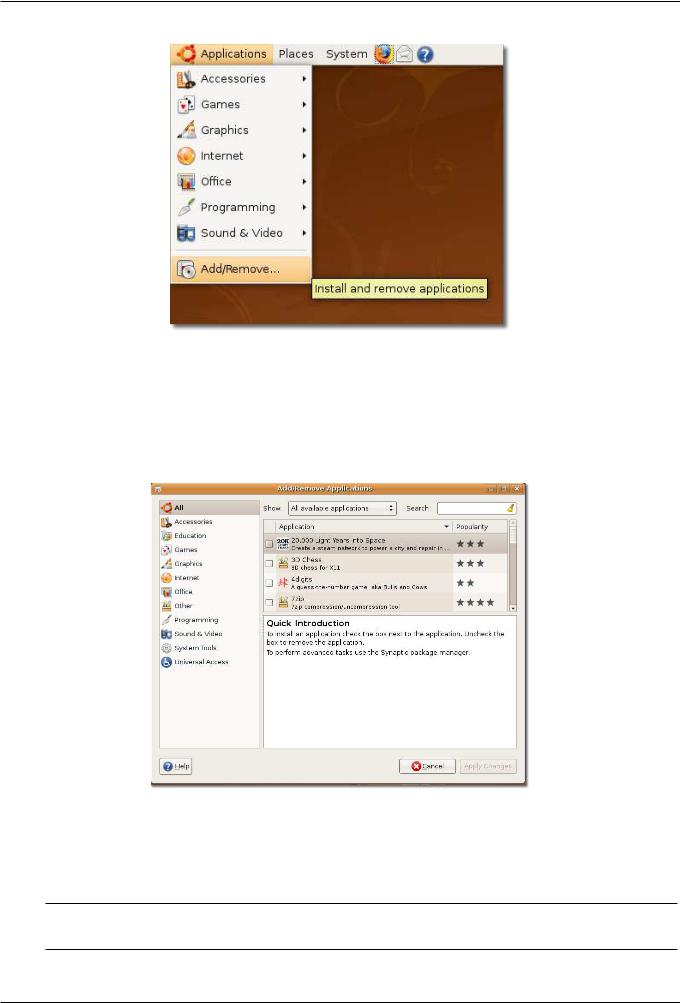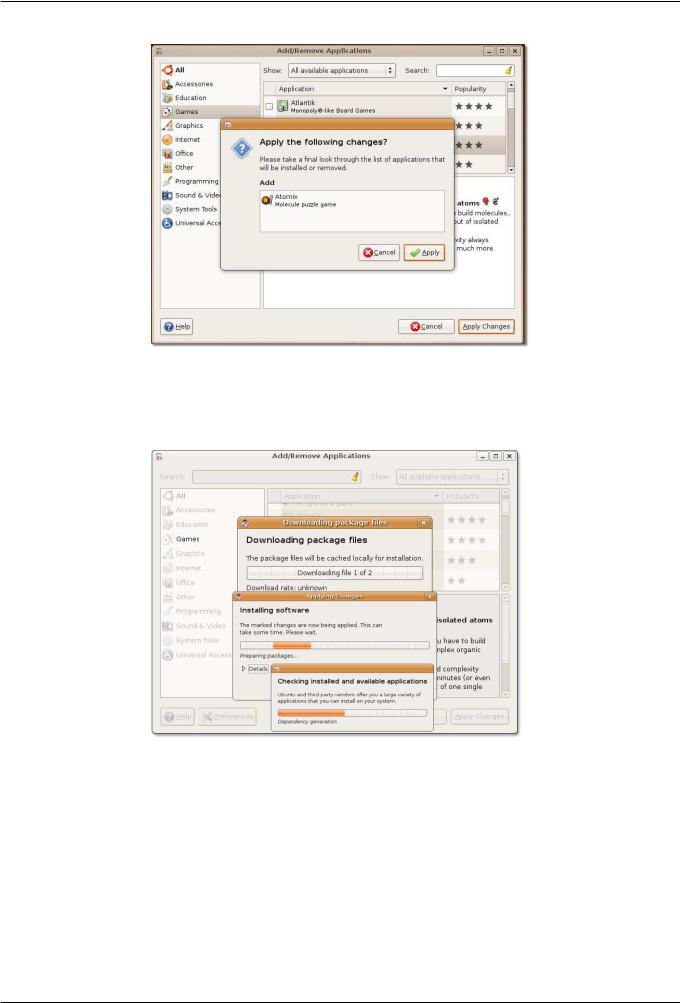
- •Introducing Ubuntu
- •About Open Source
- •Free Software Movement, Open Source and Linux
- •The Free Software Movement
- •The Open Source Movement and Linux
- •About Ubuntu
- •The Ubuntu Promise
- •Ubuntu Versions
- •Ubuntu Derivatives
- •Ubuntu Development and the Community
- •Ubuntu and Microsoft Windows: Key Differences
- •Installation
- •Applications
- •Lesson Summary
- •Review Exercise
- •Exploring the Ubuntu Desktop
- •Ubuntu Desktop Components
- •Changing the Default Language
- •Creating a User Account and Fast User Switching
- •Adding/Removing Applications
- •Desktop Effects - Compiz Fusion
- •Lesson Summary
- •Review Exercise
- •Lab Exercise
- •Using the Internet
- •Connecting to and Using the Internet
- •Network Manager
- •Using a Cable Connection
- •Using a Wireless Card
- •Browsing the Web
- •Using an RSS feed reader
- •Liferea Newsreader
- •Using Evolution Mail
- •Instant Messaging
- •Making Phone Calls Using Softphones
- •Using Ekiga
- •Skype
- •Lesson Summary
- •Review Exercise
- •Lab Exercise
- •Performing Basic Spreadsheet Tasks
- •Performing Basic Drawing Operations
- •Creating and Editing Formulae
- •Additional Applications
- •GnuCash Accounting
- •Lesson Summary
- •Review Exercise
- •Lab Exercise
- •Ubuntu and Games
- •Installing Games on Ubuntu
- •Installing a Game from a Repository
- •Playing Ubuntu Games
- •Playing PlanetPenguin Racer
- •Playing Other Popular Games
- •Installing Wine
- •Playing a Microsoft Windows Game on Ubuntu
- •Lesson Summary
- •Review Exercise
- •Lab Exercise
- •Customising the Desktop and Applications
- •Introduction
- •Customising the Desktop
- •Changing the Background
- •Customising the Theme (Buttons & icons etc)
- •Customising a Screensaver
- •Customising the Screen Resolution
- •Working with Files Using Nautilus
- •Features of Nautilus
- •Nautilus
- •Package Managers
- •Types of Package Managers
- •Using Add/Remove Applications
- •Using Synaptic Package Manager
- •Installing a Single Package File
- •Installing/Uninstalling Debian Packages
- •Software Repositories
- •Software Repository Categories
- •Adding New Language Settings
- •Lesson Summary
- •Review Exercise
- •Lab Exercise
- •Making The Most of Images and Photos
- •Introducing Graphics Applications
- •Viewing and Managing Photos with F-Spot
- •Viewing Photos
- •Organising Photos
- •Removing Red Eye
- •The GIMP
- •Drawing with Inkscape
- •Installing Inkscape
- •Creating Vector Graphic Images Using InkScape
- •Using a Scanner
- •Checking Scanner Compatibility
- •Scanning an Image
- •Lesson Summary
- •Review Exercise
- •Lab Exercise
- •Playing Music and Videos
- •Legal Restrictions
- •Playing Music Files
- •Playing Music using Rhythmbox
- •Playing and Extracting Audio CDs
- •Playing Audio CDs
- •Extracting Audio CDs
- •Burning Audio CDs
- •Playing Proprietary Multimedia Formats
- •Using an iPod
- •Playing Music Using an iPod
- •Creating and Editing Audio Files
- •Creating Audio Files
- •Editing Audio Files
- •Playing DVDs
- •Playing DVDs in Totem Movie Player
- •Backing up DVDs
- •Playing Online Media
- •Watching Videos in a Web Browser
- •Editing Videos
- •Editing videos using Pitivi video editor
- •Lesson Summary
- •Review Exercise
- •Lab Exercise
- •Ubuntu Help and Support
- •Introduction
- •System Documentation
- •Online Documentation
- •Community Support
- •Mailing Lists
- •Web Forums
- •IRC Channels
- •LoCo Teams
- •The Ubuntu Team Wiki
- •Launchpad
- •Launchpad Technical Answers
- •Launchpad Bug Tracker: Malone
- •Shipit
- •The Fridge
- •Paid For Commercial Services
- •Professional Support Services from Canonical
- •The Canonical Marketplace
- •Lesson Summary
- •Review Exercise
- •Partitioning and Booting
- •What is Partitioning
- •Creating a Partition
- •Installing GParted by Using Synaptic Package Manager
- •Partitioning Using Gparted
- •Boot-up Options
- •Changing the Default Operating System at Boot
- •Lesson Summary
- •Review Exercise
- •Lab Exercise

Ubuntu Desktop Training
175 / 335
Nice to Know:
Konqueror is KDE equivalent of Nautilus file manager, which is used in the Kubuntu derivative of Ubuntu. It is a multipurpose application that can act as a file manager, Web browser and universal viewer. As well as allowing you to browse Web sites, this application provides basic file management and can many view different file types.
6.5 Package Managers
One of the biggest differences between Ubuntu and other operating systems is how you install and uninstall applications. In Microsoft Windows, most applications provide their own installation and removal methods. Some applications provide a method to keep themselves up to date, but others do not and there is no easy way to ensure that everything on your computer is up to date. Keeping track of all the programmes that have been installed and keeping all those programmes updated is largely up to you.
Ubuntu has a sophisticated package management framework that keeps track of all the software installed, automates the process of installing and removing applications, and ensures that all the software is kept up to date with the latest enhancements and fixes. All you have to do is decide what applications you want installed, and then use a package manager to tell Ubuntu to install them.
6.5.1Types of Package Managers
Note:
Ubuntu includes a few package managers by default and which one you use depends on how advanced the package management tasks are that you want to achieve. This course covers Add/Remove applications utility and the Synaptic Package Manager.
If you open more than one package manager at the same time, they may not work. Close all the package managers and open just one.
6.6 Using Add/Remove Applications
Note:
The Add/Remove tool is the easiest to use and will enable you to install and uninstall many popular packages. You can search for the package or packages you want to install by simply searching a keyword such as ’email’ or by looking through the given categories, selecting applications and choosing "Apply" to start the installation.
You need administrative access to use any package manager. Type the password for your user name at the prompt. This means that applications can not be added / removed from your computer without your knowledge (and password).
1. On the Applications menu, click Add/Remove.

Ubuntu Desktop Training
176 / 335
Figure 6.32: Launching Add/Remove Applications
2.The Add/Remove Applications dialogue box displays a list of applications. The check boxes against the applications that are already installed are pre-selected. NOTE:
Many package names in Ubuntu are quite obscure, so the package manager will also look at the package description when searching.
Figure 6.33: Add/Remove Applications Window
3.If you know the name of the package to be installed, you can type the name in the Search box. Otherwise, you can click the appropriate software category in the left pane and select the check box next to the required package in the right pane.
Nice to Know:
For more details about a package, click the package and view the bottom pane.

Ubuntu Desktop Training
177 / 335
Figure 6.34: Searching for a Package in All Available Applications
4. When you have finished selecting the packages to be installed or removed, click Apply Changes.
Figure 6.35: Applying Changes to the Package List
5. You are prompted to confirm your selection. Click Apply to proceed.

Ubuntu Desktop Training
178 / 335
Figure 6.36: Confirming Changes
6. The progress indicator shows the status of the package being installed or removed.
Figure 6.37: Installing Selected Package from Repositories
7. After the changes are applied successfully, the package is installed.
